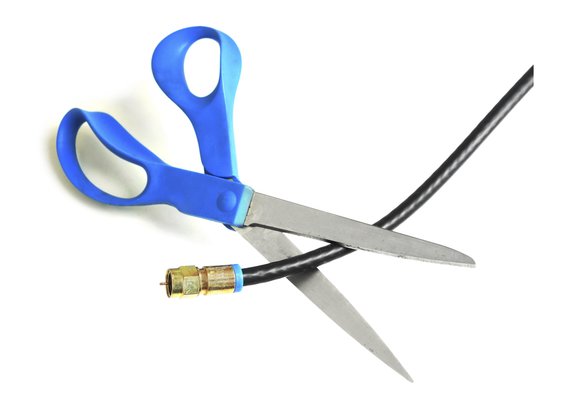
A quick news search will turn up unlimited babble on the topic of cord-cutting. Heck, there’s a popular site and daily newsletter devoted to the topic, which I recommend. And you can save some money. Probably. YMMV.
Funny, since mileage didn’t vary much just a little while ago. Cable costs a lot, but depending on how you look at it, you get a lot – including a lot you likely don’t want, but still. Streaming promises more selectivity for the buyer, at lower prices.
But there’s one constant in this world, besides gridlock in Washington: content costs a lot to produce and distribute. Vast industries are built on this truth. And we are all victims.
Severing the cord: my experience
I used to play Comcast and DirecTV (never Dish, for some reason) off one another, switching annually (more or less) to capture intro deals. But that slowly became exhausting and less lucrative. And anyway, I heard wondrous stories of cut cords that promised savings aplenty.
So there I sat, grumpily, with Comcast as my provider. To set the stage, my (previous) cable service package included:
- The “Digital Starter” package. 140+ channels (which feels like a lot, but really, it was mostly noise); local, sports, but no HBO, Showtime, etc. I was shunned by Game of Thrones fans, but so be it. (see Xfinity channel lineups here)
- the “X1” DVR/cable box, which is a major improvement over their older tech. Comcast customers know what I mean. For example, they’ve integrated access to Netflix and other enemy services into their system, a nice touch.
- “Performance Pro” Internet, 150MB download speed. I own my modem, so one cost was avoided (probably ~$10/month). You should too, btw – perfectly decent ones run $60+, so you’ll get your money back fast, and you’ll still have a resellable asset if you ever change to another provider.
- A secondary cable box for another room. This is one of the leading “death by 1,000 cuts” elements of cable pricing that customers know so well. Silly. I pay for service AND I pay for a means to consume the service?
For all these wonders – and believe me, this is bare bones, except for Internet speed – I was paying Comcast (Xfinity, if you must) the princely sum of $124/month, all in, post intro deal, which they still claimed was $30 less since I was a bundler. Harumph. Seemed like a lot.
In fairness, I also pay separately for Netflix, on their basic family plan, which runs ~$15 month (unless you’re a TMobile customer, as I am, then Netflix is on them). I’m also an Amazon Prime customer, which allows access to their video library. And, in violation of my core beliefs, I fell for a promotion a while back that offered Hulu roughly for free for a few months. It’s normally $6/month.
The new age dawns
After some research, I settled on a replacement plan: YouTube TV (not to be confused with “regular” YouTube, a totally separate service). Nowhere near as many channels, but including local and a decent sports lineup for $40/month (since raised, ironically, to $50), with no contracts, equipment to buy, and virtually unlimited Cloud DVR.
There are many choices, for sure. For example, if you’re not devoted to sports, you can find equivalent or better deals with SlingTV, Hulu with Live TV, and others. Check out your options here.
Obviously, I still needed Internet, so Comcast was not entirely kicked to the curb. But, importantly, after some more research, it became clear that 150MB download speed was major overkill for how I used it. I downgraded by speed to 50MB, and have never noticed even a little difference. The savings was ~$30/month. Again, YMMV depending on your usage patterns (gaming, in particular).

My “Smart” Samsung TV includes access to most major streaming services, but I found the performance and interface to be awful. So I coughed up ~$30 for a Roku streaming stick. It’s an adjustment from the Comcast remote and UI, but nothing overwhelming. And I bought a decent antenna for local channels – most of which are provided by YouTube TV, but not all. You could probably skip this, but it’s a one-time expense.
I hung onto to Netflix, Amazon, and Hulu, so that’s a wash, financially.
So here’s the breakdown:

The bottom line is that I save ~$35/month, not exactly a king’s ransom. However, I traded off a lot of superfluous content, contracts, and hardware for a more flexible, slightly cheaper package of channels I actually watch.
My conclusion: if you legitimately like the streaming solution you pick – instead of putting up with something you don’t to save a few bucks – you’ll be happier. So choose your streamer carefully.
A few additional thoughts:
- If you have the AmEx Blue Cash Preferred card, they now offer an attractive 6% back on all your streaming services. That helps.
- The price I was paying for the cable bundle includes faster internet than I really needed, so I might have saved by downgrading, while remaining bundled. Never hurts to call your provider and see what they’re offering today.
- Put Trim to work, and don’t be surprised is they turn up some occasional savings. I’ve seen some in my Internet bill, among others, and it’s possible they’ll find ways to strong arm streamers as well.
- To be fair, if you play the intro pricing game well, you can drive cable bundle price substantially lower, but then you’re locked in for at least a year. Not a fan.
If you’ve had similar or different cord cutting experiences, comment. I’m all ears on how to squeeze more savings from this change.
